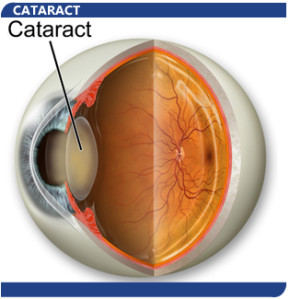Cataracts
What is a Cataract?
A cataract is a clouding of the eye’s natural lens, which lies behind the iris and the pupil. The lens works much like a camera lens, focusing light onto the retina at the back of the eye. The lens also adjusts the eye’s focus, letting us see things clearly both up close and far away.
The lens is mostly made of water and protein. The protein is arranged in a precise way that keeps the lens clear and lets light pass through it.

As we age, some of the protein may clump together and start to cloud a small area of the lens. This is a cataract, and over time, it may grow larger and cloud more of the lens, making it harder to see. Researchers are gaining additional insights about what causes these specific types of proteins (crystallins) to cluster in abnormal ways to cause lens cloudiness and cataracts. One recent finding suggests that fragmented versions of these proteins bind with normal proteins, disrupting normal function.
You can see the cloudy area in the pupil of the eye. This is a cataract.
Cataracts are classified as one of three types:
- A subcapsular cataract begins at the back of the lens. People with diabetes, high farsightedness, retinitis pigmentosa or those taking high doses of steroids may develop a subcapsular cataract.
- A nuclear cataract is most commonly seen as it forms. This cataract forms in the nucleus, the center of the lens, and is due to natural aging changes.
- A cortical cataract, which forms in the lens cortex, gradually extends its spokes from the outside of the lens to the center. Many diabetics develop cortical cataracts.


